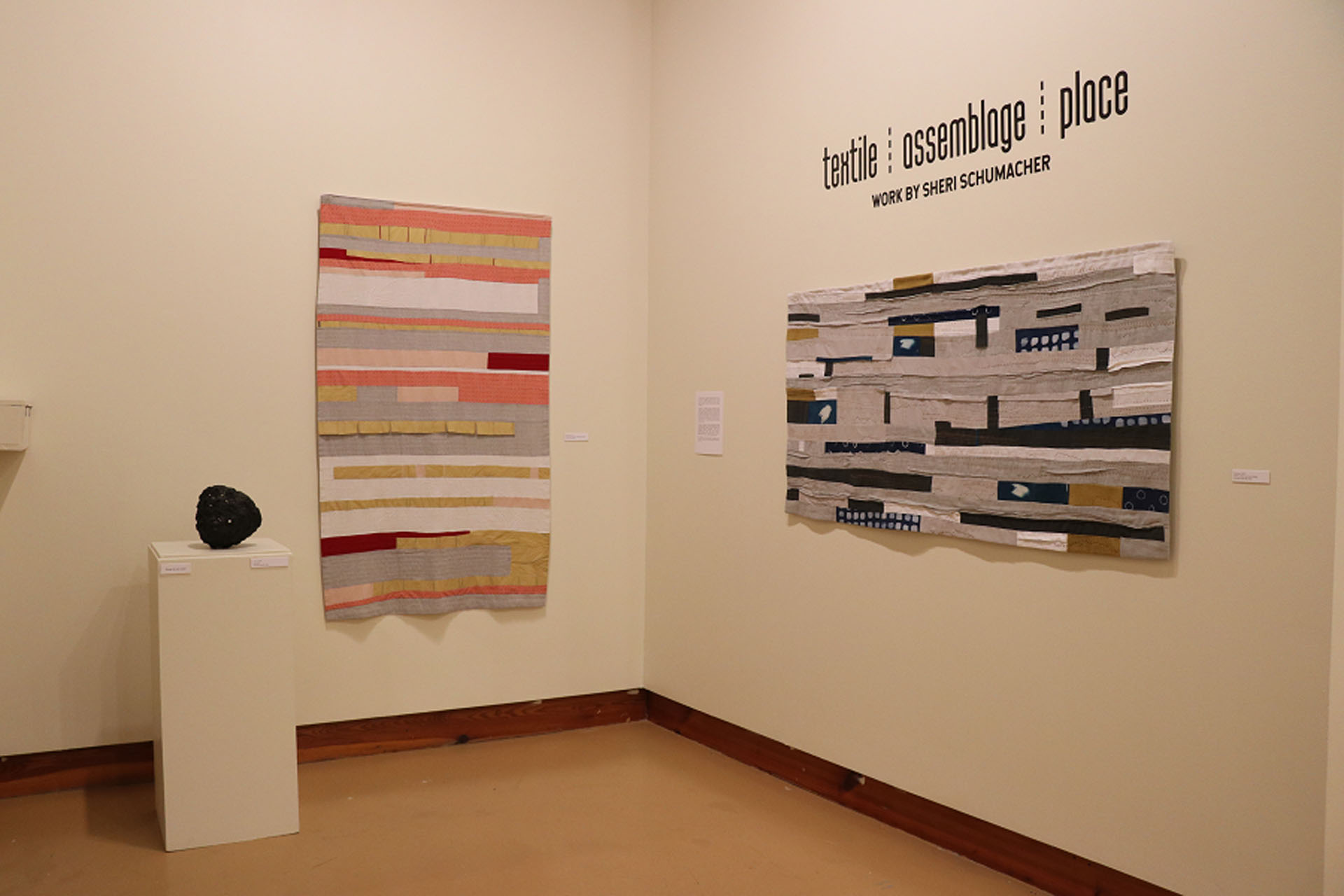
Get to Know Artist Sheri Schumacher
Sheri Schumacher is a designer and educator whose work is at the interface of architecture, public-interest design, and craft practices. In her WMA exhibition, textile | assemblage | place, Schumacher sets out to “map” the sensory experience of place by recording cultural landscapes with textiles.
Schumacher uses repurposed materials, including linens and clothing in her work, often combining them with new textiles creating an innovative and improvised use of material. She has been particularly inspired by the quilters of Gee’s Bend, who use repurposed clothing and fabric to create compositions with a bold use of color and design. She is equally inspired by the unique characteristics of different places and explores ways in which her textile work can physically map the terrain and the experience of place.
Schumacher is an advocate for creative economies that encourage relationships between places of making, materiality, tools, and handmade production. Inspired by regional craft heritage and hand-stitching traditions, her recent textile assemblages explore narratives about cultural landscapes. Discovery through the act of making and the physical engagement with materials is central to her design process.
WMA’s director, Dana-Marie Lemmer, had a chance to ask Sheri a few questions about textile | assemblage | place, as well as her creative inspiration and artistic process, earlier this month. Please read the interview and be sure to come see the exhibition at WMA through March 30!
_____________________________________________________________________
Tell us a little bit about the series of work on display at Wiregrass Museum of Art. What is the work about?
This series of work aims to map the sensory experience of place and record cultural landscapes with textiles. Repurposed textiles, linens and clothing are assembled and hand sewn to explore narratives about the nature of place. Narratives include places of geological resilience and fragility found in the Annapurna region of Nepal, pilgrimage sites layered with sari garments, quietude of snow in a forest, cultivation of farm land and township grids of the US Public Land Survey System.
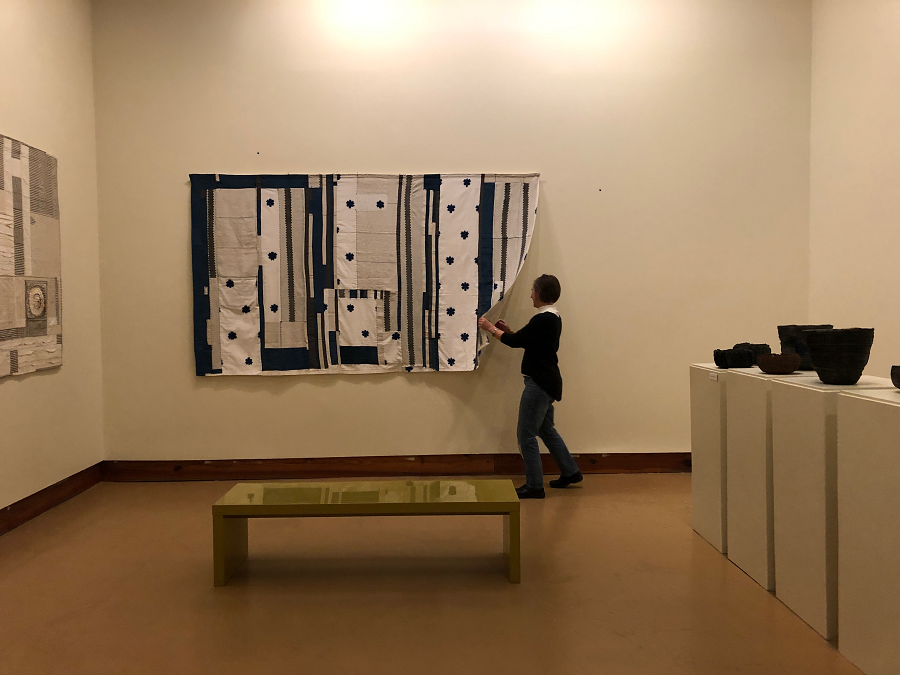
Sheri Schumacher installing “Forest Snow” (2018, Line, indigo-dyed repurposed linens, vintage Japanese indigo-dyed cotton, hemp/linen grain sack, cast iron), a piece from her WMA exhibition textile | assemblage | place, in the Blumberg Gallery
When did you begin working in textile, and when did you begin to make the connection to specific places you’ve visited?
I began working with the medium of textiles six years ago and made the connection to specific places I’ve visited two years ago.
Where do you get your inspiration from?
My inspiration comes from experiencing and learning from cultural and natural landscapes. Cultures that use ingenuity when making things, from objects of use to dwellings are of particular interest to me because of their use of local, sustainable and readily available resources in the making process. The terrain and topological conditions experienced natural landscapes provides an opportunity to physically map the terrain while also recording the experience of place using all the senses.
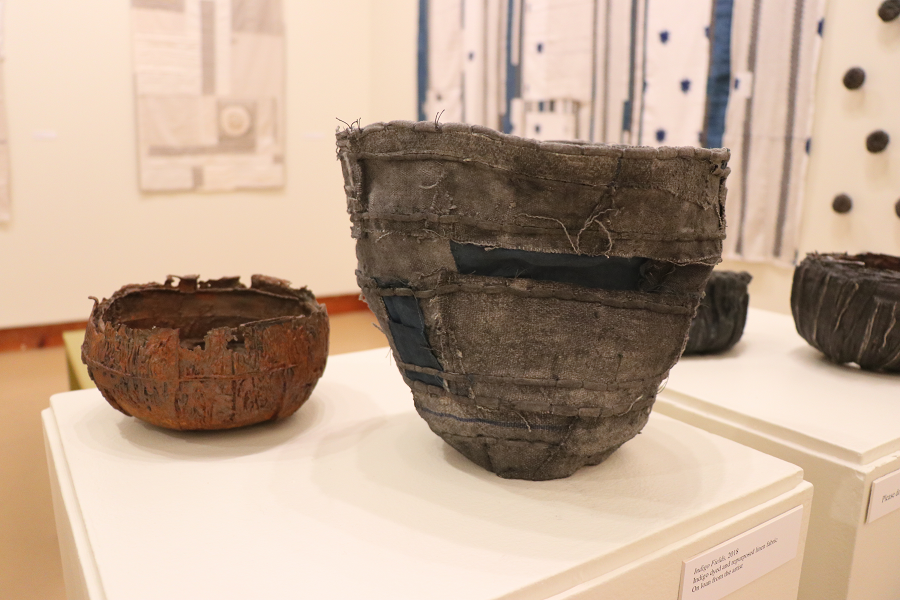
Right : “Indigo Fields,” 2018, Indigo-dyed and repurposed linen fabric Left : “Tree Bark,” 2017, Cast iron
Why did you begin making metal work, and how has that influenced your quilting practice (if it does)? How has your quilting work influenced the iron work?
I began making iron vessels two years ago when discovering it was possible to use fabric in the pattern and mold making process at Sloss Metal Arts in Birmingham, AL. Of particular interest is the fragile nature of the fabric which disintegrates over time in contrast to the enduring qualities of iron. The fabric patterns for iron casting and quilting practice influence one another.
My first iron vessels using fabric patterns were inspired by the rice fields and terrain experienced in the Annapurna region in Nepal. These small fabric patterns pieced with scraps using a range of sewing techniques provided inspiration for exploring the same landscape at a larger scale with the ‘Kagbeni’ wall mounted textile. This work in turn influenced the fabric pattern and mold used to cast the ‘Kagbeni’ iron vessel.
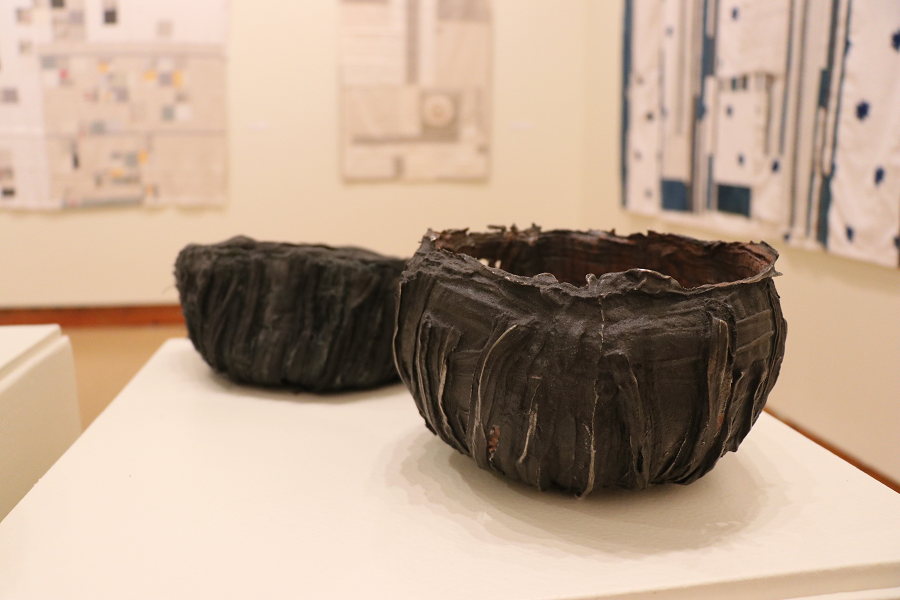
Foreground: “Kagbeni,” 2017, Cast iron Background: “Kagbeni,” 2017, Indigo-dyed linen and cotton fabric
Tell us about your background in architecture and design. How does that experience influence your studio practice?
My education, professional practice and teaching in the discipline of design and interior architecture has significantly influenced my studio practice, in terms of content, process and material investigations.
Spaces where life occurs in the physical environment influences all of my work; enclosure, relationship of inside to outside, space defining elements such as boundaries, edge and territory. I’m also influenced by the character of places, how a place changes with different conditions of light and time and their material culture, how things are made, assembled and visible traces on materials with evidence of their history and use over time.
Cultures that have influenced my design, teaching and studio practice include places such as Nepal, Mexico, and Ecuador because the people who live there are closely tied to the land, nurture the place where they live and contribute beauty to their environment and others with limited resources. Closer to home, I am influenced by the Gee’s Bend quilters of Alabama. Their quilts have qualities of improvisation, innovative use of repurposed clothing and fabric remnants, beautiful design composition and use of color, and expressive hand quilting. Their quilts have not only inspired mid 20th century art in America but also have been a source of inspiration around the world. The Gee’s Bend quilters have influenced how I teach design composition, process and color theory, they inspired architectural investigations with students for the Gee’s Bend community, provided exemplary examples of teaching quilting workshops and most importantly, these remarkable women taught me how to sew and work with textiles.
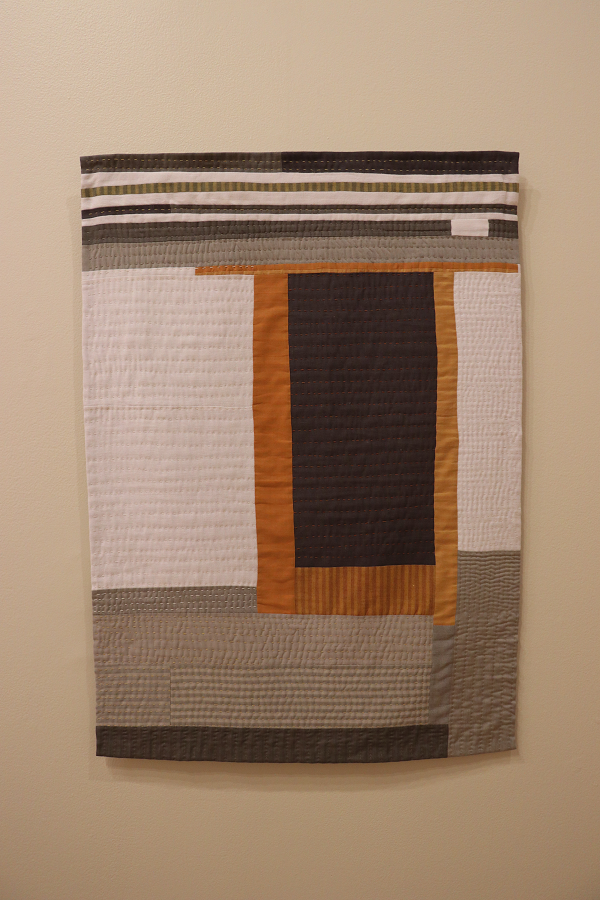
“Threshold,” 2018, Linen and cotton fabric
Is there a particular piece in the exhibition that you love, and why? Or is there a particular piece that was particularly challenging?
‘Kagbeni’ is significant to me because it was the first work that combined my interest in mapping the experience of place in architecture with the medium of textiles. The piece was inspired by the sensory experience of a dust storm encountered when trekking along the Kali Gandaki gorge in Nepal, a trade route between India and Tibet. The challenge was to create a narrative about this particular place and experience, including the movement of water, sounds of wind, blinding sand storm and migration on horseback, with repurposed fabrics and hand stitching techniques.
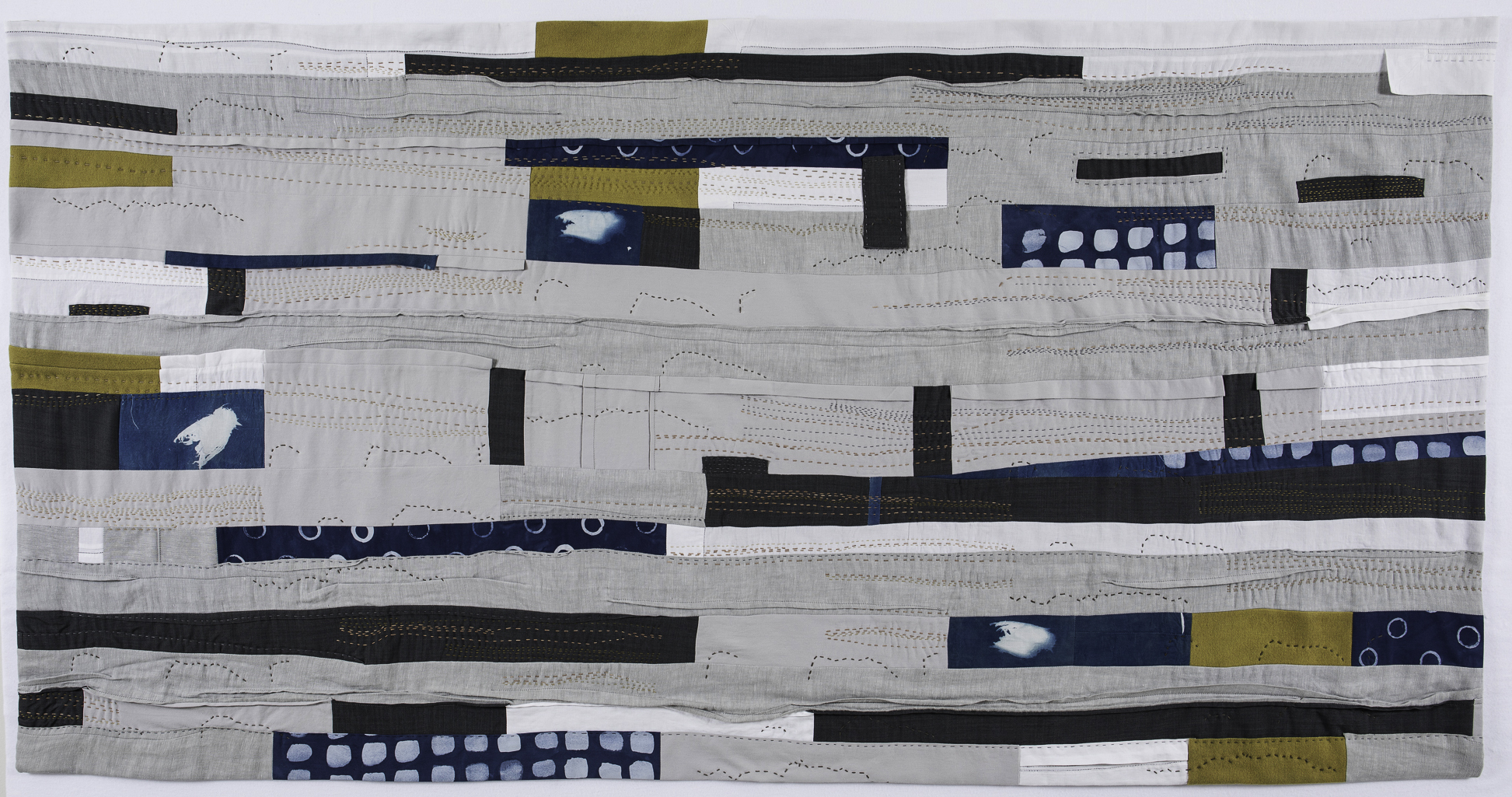
“Kagbeni,” 2017, Linen, cotton, and wool fabric
What does it mean to be showing your work at WMA?
It is an honor to show my work at the WMA, my first solo exhibition in a museum. The museum’s commitment to educational programming focused on the exhibit, especially for children, is one of the most meaningful aspects of showing my work at the WMA. Seeing photos of children looking at the fabric patterns used to make the molds along side the iron vessels made me realize the importance of curating work to include aspects of the making process.
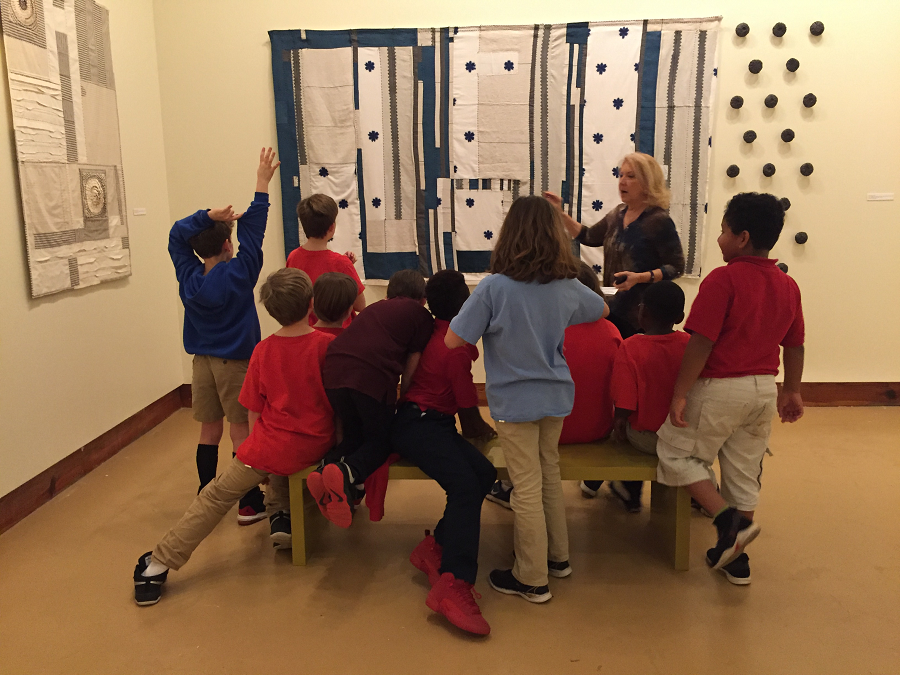
What are you working on next?
I’m working on a series of quilts inspired by the Alabama gulf coastal plain landscape. The pieces are made primarily with Red Land Cotton fabric remnants of cotton grown in Alabama for the Gulf State Park.
Anything else you’d like to add?
Thank you for this opportunity, I thoroughly enjoyed the interaction with and support of the WMA director and staff when working on the exhibit.
